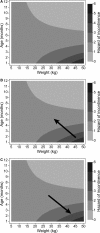Urethral Sphincter Mechanism Incompetence in 163 Neutered Female Dogs: Diagnosis, Treatment, and Relationship of Weight and Age at Neuter to Development of Disease
- PMID: 28256023
- PMCID: PMC5354041
- DOI: 10.1111/jvim.14678
Urethral Sphincter Mechanism Incompetence in 163 Neutered Female Dogs: Diagnosis, Treatment, and Relationship of Weight and Age at Neuter to Development of Disease
Abstract
Background: Urethral sphincter mechanism incompetence (USMI) is the most common cause of urinary incontinence in neutered bitches and is most common in dogs weighing >20 kg.
Objectives: To describe a population of neutered bitches with USMI and investigate their initial presentation, the relationship between weight and age at neuter, and treatment.
Animals: One hundred and sixty-three female dogs with USMI (UI) diagnosed between January 2009 and December 2012, and 193 continent neutered control (C) bitches.
Methods: Retrospective data were collected from neutered female dogs with USMI and healthy, continent neutered females presented between January 2009 and December 2012.
Results: Urinary incontinent dogs weighed more than C dogs (P = .003), and there was no difference in age at neuter. The relationship between weight at diagnosis and age at neuter was found to impact the hazard of USMI. A decrease in the hazard of USMI was found in dogs weighing >25 kg for every month delay of neuter in the first year. The hazard did not change for dogs <15 kg. Median time from neuter to development of incontinence was 3.73 years. Phenylpropanolamine was prescribed in 75.5%, diethylstilbestrol in 21.5%, and both in 3.1% of dogs.
Conclusions and clinical importance: Neutering bitches expected to be >25 kg adult weight later in their first year may decrease the hazard of developing USMI, whereas age at neutering of bitches <25 kg may not impact continence. Heavier dogs have increased risk of USMI, and onset occurs within a few years of neuter.
Keywords: Incontinence; Ovariohysterectomy.
Copyright © 2017 The Authors. Journal of Veterinary Internal Medicine published by Wiley Periodicals, Inc. on behalf of the American College of Veterinary Internal Medicine.
Figures

References
-
- Gregory SP, Parkinson TJ, Holt PE. Urethral conformation and position in relation to urinary incontinence in the bitch. Vet Rec 1992;131:167–170. - PubMed
-
- Gregory SP, Holt PE, Parkinson TJ, et al. Vaginal position and length in the bitch: Relationship to spaying and urinary incontinence. J Small Anim Pract 1999;40:180–184. - PubMed
-
- Augsburger HR, Oswald M. Immunohistochemical analysis of collagen types I, III, IV and alpha‐actin in the urethra of sexually intact and ovariectomized beagles. Int Urogynecol J Pelvic Floor Dysfunct 2007;18:1071–1075. - PubMed
-
- Byron JK, Graves TK, Becker MD, et al. Evaluation of the ratio of collagen type III to collagen type I in periurethral tissues of sexually intact and neutered female dogs. Am J Vet Res 2010;71:697–700. - PubMed
-
- Rud T, Andersson KE, Asmussen M, et al. Factors maintaining the intraurethral pressure in women. Invest Urol 1980;17:343–347. - PubMed
MeSH terms
Substances
LinkOut - more resources
Full Text Sources
Other Literature Sources
Medical

